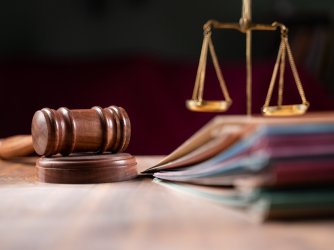Table of Contents
Religious liberty in the United States: An inalienable right
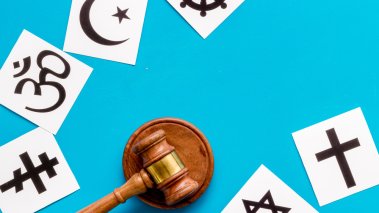
No freedom may be more central or important to the human spirit and condition than freedom of religion and conscience — and none may be more dangerous to limit. Religious liberty is the ability to believe and practice one’s religious faith, or to practice none at all, free from governmental interference.
As former FIRE president David French writes in FIRE’s “Guide to Religious Liberty on Campus”: “America is a nation, that, from its founding, has proclaimed the rights of religious liberty and religious diversity.” As David emphasizes, for James Madison and his fellow Founders, “religious liberty was an inalienable right.”
The first sixteen words of the Bill of Rights contain the two religious liberty clauses of the First Amendment: the Establishment Clause and the Free Exercise Clause. The first 10 words of the First Amendment collectively comprise the Establishment Clause — “Congress shall make no law respecting an establishment of religion.” The next six words — “or prohibiting the free exercise thereof” — comprise the Free Exercise Clause.
The Establishment Clause is the part of the First Amendment that prevents the state from controlling or mandating religion. The Free Exercise Clause is the part that protects our religious belief and practice. We can believe in God, Buddha, the Flying Spaghetti Monster, or nothing at all. The Free Exercise Clause protects the deeply devout to the fiercely atheistic — and everything in between.
Neither a state nor the Federal Government can, openly or secretly, participate in the affairs of any religious organizations or groups, and vice versa.
At times the two clauses are complementary, as they both generally require the government to be neutral with respect to religion. At times, however, the two clauses can exert competing pressures. Consider a public high school valedictorian who wants to deliver a religious message in her graduation speech. She seeks to assert her free-exercise clause rights to practice religious liberty. But school officials claim that allowing her to share a religious message before this audience at a school-sponsored event like graduation will violate the Establishment Clause and effectively result in the government promoting religion.
Establishment clause of the First Amendment
Those first ten words of the First Amendment may be subject to more differing interpretations than any in the entire Constitution. As a result, author Stephen Mansfield called these “Ten Tortured Words,” using this phrase in part because of how differently these ten words have been interpreted through the years.
The Supreme Court explained the meaning of the Establishment Clause in Everson v. Board of Education (1947), a case involving a law that allowed school districts to reimburse parents for the costs of bus transportation to and from religious schools. Writing for the majority, Justice Hugo Black explained:
The “establishment of religion” clause of the First Amendment means at least this: neither a state nor the Federal Government can set up a church. Neither can pass laws which aid one religion, aid all religions, or prefer one religion over another. Neither can force nor influence a person to go to or to remain away from church against his will or force him to profess a belief or disbelief in any religion . . . Neither a state nor the Federal Government can, openly or secretly, participate in the affairs of any religious organizations or groups, and vice versa. In the words of Jefferson, the clause against establishment of religion by law was intended to erect “a wall of separation between church and State.”
In that case, the law was upheld. But fifteen years later, the Court created massive public controversy when it invalidated the longstanding practice of educator-led prayer in public schools. In Engel v. Vitale (1962), the Court explained “[i]t is neither sacrilegious nor antireligious to say that each separate government in this country should stay out of the business of writing or sanctioning official prayers and leave that purely religious function to the people themselves and to those the people choose to look to for religious guidance.”
The Lemon test and its eventual demise
In 1971’s Lemon v. Kurtzman, the Court laid out what would come to be known as the “Lemon test” for evaluating whether a law violated the Establishment Clause. To survive that test, the law (1) must have a secular purpose; (2) its primary effect must neither advance nor inhibit religion; and (3) it must not result in excessive government entanglement with religion.
While the Lemon test would be used in some form for many years, it took only 11 years before exceptions started to crop up. In Marsh v. Chambers (1983), a case involving a challenge to the Nebraska legislature’s practice of hiring a chaplain to open legislative sessions with a prayer, the Court focused instead on the history and tradition of prayer in legislative bodies, including the U.S. House of Representatives.
“The opening of sessions of legislative and other deliberative public bodies with prayer is deeply embedded in the history and tradition of this country,” wrote Chief Justice Warren Burger for the majority, which upheld the practice.
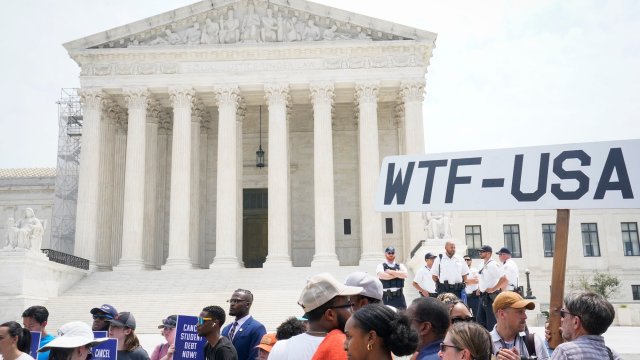
Myth-busting reactions to the Supreme Court’s decision in 303 Creative v. Elenis
News
Once again, the culture wars distort a clear win for pluralism and the First Amendment.
The following year, in her concurring opinion in Lynch v. Donnelly, a case involving the display of a creche alongside several secular Christmas symbols (reindeer and Santa Claus), Justice Sandra Day O’Connor offered what she called a “clarification” of Lemon: the “endorsement test.” Justice O’Connor explained that impermissible “[e]ndorsement sends a message to nonadherents that they are outsiders, not full members of the political community, and an accompanying message that they are insiders, favored members of the political community.”
The Lemon test continued to come under fire as the years went on. Perhaps most famously (or infamously, depending on your perspective), Justice Scalia called Lemon “some ghoul in a late-night horror movie” that “still stalks our Establishment Clause jurisprudence” in Lamb’s Chapel v. Center Moriches Union Free School District (1993), complaining about the Court’s inconsistency in applying the test and noting that five of the current justices wrote opinions opposing its use in various circumstances.
Despite the Supreme Court’s criticism, Lemon remained a part of Establishment Clause jurisprudence and, in fact, remained the dominant test used in the lower courts for almost 50 years. In the 2010s, however, multiple Supreme Court cases started to walk back the Lemon endorsement test and instead ask whether a challenged religiously expressive monument, symbol, or practice has been in place for a long time without being banned under the Establishment Clause, with reference to historical practices and understandings. Thus, in Town of Greece v. Galloway (2014), a town board meeting could begin with a prayer, and in American Legion v. American Humanist Association (2019), a World War I cross monument to fallen soldiers could remain on public land, regardless of whether opening prayers or cross monuments passed the Lemon test, because they were longstanding practices.
Finally, in Kennedy v. Bremerton School District (2022), the Supreme Court fully overruled Lemon. Justice Neil Gorsuch’s majority opinion declared: “[T]his Court long ago abandoned Lemon and its endorsement test offshoot.”
Following Lemon’s demise, the landscape has changed. “With Lemon finally dead, the question is what comes next,” the U.S. Court of Appeals for the Fourth Circuit recently wrote in Firewalker-Fields v. Lee (4th Cir. 2023) (internal citations omitted):
Kennedy gives the answer: “In place of Lemon and the endorsement test, this Court has instructed that the Establishment Clause must be interpreted by ‘reference to historical practices and understandings.’” From now on, historical practice and understanding “must” play a central role in teasing out what counts as an establishment of religion.
It appears that Lemon has finally been interred, and the key factor in Establishment Clause cases is now whether a practice is rooted in historical traditions, similar to the analysis Chief Justice Burger conducted writing for the majority in Marsh.
The Free Exercise Clause
The Free Exercise Clause guarantees Americans absolute protection for freedom of religious belief, and protects religious conduct so long as it does not irreconcilably violate a neutral public health, safety, and welfare law.
For example, in Wisconsin v. Yoder (1972), the state of Wisconsin required all children to attend public or private school until age 16. Jonas Yoder, Wallace Miller, and Adin Yutzy were all convicted of violating this law for pulling their children out of school after the eighth grade, as required by their Amish and Mennonite faiths. They challenged their criminal convictions as violations of their religious liberty.
The Supreme Court agreed with Yoder. It held that while there is “no doubt as to the power of a State, having a high responsibility for education of its citizens, to impose reasonable regulations for the control and duration of basic education,” a government’s interest in education “is by no means absolute to the exclusion or subordination of all other interests.” As such, Wisconsin’s interest did not outweigh Amish parents’ sincere religious belief that their children should not attend school past a certain age.
By contrast, in Reynolds v. United States (1879), George Reynolds faced prosecution for polygamy, but argued that the prosecution violated his religious liberty rights because that practice was compelled by his religious faith.
But the U.S. Supreme Court ruled in favor of the government and against Reynolds because marriage is an “important feature of social life” and society, and as such Congress could define its outer bounds. “To permit this would be to make the professed doctrines of religious belief superior to the law of the land, and, in effect, to permit every citizen to become a law unto himself,” wrote Chief Justice Morrison Waite for the Court. “Government could exist only in name under such circumstances.”
In the early 1960s, the Supreme Court ruled that the government could not infringe upon a person’s free-exercise rights unless the government’s action could survive “strict scrutiny” — that is, a showing that the regulation burdening this freedom was advancing a compelling governmental interest in the least restrictive way possible. In the 1963 decision Sherbert v. Verner, the Court ruled that the state of South Carolina violated the free-exercise rights of Seventh Day Adventist Adele Sherbert by denying her unemployment compensation when she was terminated for refusing to work on Saturday, her Sabbath day.
But the Court changed course abruptly in Employment Division v. Smith (1990), a case also involving unemployment compensation benefits and religious faith. Alfred Smith and Galen Black, members of the Native American Church, were fired after they ingested peyote, a hallucinogenic drug, for religious reasons. The state of Oregon denied their application for benefits, citing state policy against illegal drug use.
In his majority opinion, Justice Antonin Scalia ruled that the government does not violate the Free Exercise Clause when it acts pursuant to a neutral and generally applicable law that does not target religion but merely has an incidental effect on it.
“We have never held that an individual’s religious beliefs excuse him from compliance with an otherwise valid law prohibiting conduct that the State is free to regulate,” Justice Scalia wrote, harkening back to the George Reynolds polygamy decision.
Others viewed the decision as a significant loss of religious liberty. In her concurring opinion, Justice Sandra Day O’Connor wrote: “In my view, today’s holding dramatically departs from well-settled First Amendment jurisprudence, appears unnecessary to resolve the question presented, and is incompatible with our Nation’s fundamental commitment to individual religious liberty.”
What has not changed is the law’s general recognition that religious liberty is among the central foundations of American freedom, and that our government must not target or discriminate against religious faiths or those who practice them.
Since Smith, the Court has clarified that being “neutral” and “generally applicable” is a high bar. For example, three years after Smith, the Court invalidated a Florida city ordinance that targeted the Santeria practice of animal sacrifice. Justice Anthony Kennedy explained in Church of the Lukumi Babalu Aye v. City of Hialeah (1993): “Legislators may not devise mechanisms, overt or disguised, designed to persecute or oppress a religion or its practices. The laws here in question were enacted contrary to these constitutional principles, and they are void.”
In recent years, the Court has also applied strict scrutiny to invalidate laws that bar religious access to generally available programs. For example, in Fulton v. City of Philadelphia (2021), the Court held that a city ordinance requiring foster care organizations to allow placements with gay couples was not generally applicable to a Catholic foster care organization because the ordinance allowed exceptions to the rule. And in Carson v. Makin (2022), the Court held that Maine violated the Free Exercise Clause when it withheld a state-funded tuition benefit to parents who wanted to send their children to religious schools, because the benefit was generally available to be used at any other type of school.
The Religious Freedom Restoration Act and the Religious Land Use and Institutionalized Persons Act
Worried that the Smith decision would have a dramatically negative impact on free-exercise protections in the country, Congress passed the Religious Freedom Restoration Act (RFRA) in 1993, which restored the compelling-interest test articulated in the Sherbert decision.
Under RFRA, the government cannot substantially burden the free exercise of religion unless the government advances a compelling governmental interest in the least restrictive means. Effectively, RFRA represented a legislative overturning of the Court’s decision.
A few years later, the Supreme Court ruled that Congress exceeded its bounds in applying RFRA to state and local governments in City of Boerne v. Flores (1997). Essentially, the Court said Congress trampled on states’ rights by deciding the question for states. However, RFRA still applies to federal actions.
After Flores, Congress once again responded with another federal religious law called the Religious Land Use and Institutionalized Persons Act (RLUIPA), which was similar to RFRA but not quite as broad. It applied to land use and prisoner cases and was grounded on Congress’s Commerce Clause and Spending Clause powers, rather than just Congress’s powers under Section 5 of the Fourteenth Amendment. Many states have also enacted state RFRAs that would apply to state law and several state courts have interpreted their state constitutions in a more religious-freedom protective manner than Smith.
What this means is that often, individuals — and even some corporations — may have greater religious liberty protections under federal statutes (either RFRA or RLUIPA), state constitutions, or state statutes than under the Constitution through the Free Exercise Clause. That’s why individuals often file statutory claims for religious liberty under RFRA or RLUIPA, instead of constitutional claims under the Free Exercise Clause.
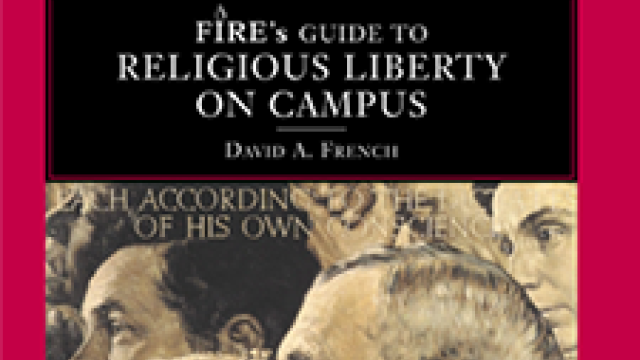
FIRE's Guide to Religious Liberty on Campus
Campus Guides
FIRE’s Guide to Religious Liberty on Campus explains how the legal and moral arguments for religious liberty apply to public and private colleges.
This pattern may change given that in recent years, the Supreme Court has emphasized the importance of the Free Exercise Clause and it appears to be strengthening its protections. For example, in his majority opinion in Kennedy, Justice Gorsuch spoke of the First Amendment’s “double protection for religious expression” under both the Free Exercise and Free Speech Clauses of the First Amendment. In that case, the Court found that school district policies that led the district to punish a football coach for praying on the 50-yard-line at the conclusion of games were not neutral and generally applicable. And in recent decisions like Fulton v. City of Philadelphia, the Court has emphasized that laws or policies departing from Smith’s requirements of neutrality and general application are subject to strict scrutiny.
Further cases involving the intersection between anti-discrimination laws and religious liberty are inevitable, and may well provide even more guidance as to the level and meaning of the Free Exercise Clause to this current Court.
Religious liberty: An essential freedom
The Supreme Court has been active recently in both the Establishment and Free Exercise areas. In the Establishment Clause arena, the Court has abandoned the test set out in Lemon in favor of an analysis based on history and tradition — a standard that will often be more permissive of policies that allow government interaction with religion. Meanwhile, the Court has emphasized and strengthened the vitality of the Free Exercise Clause, but exactly how much remains to be seen.
What has not changed is the law’s general recognition that religious liberty is among the central foundations of American freedom, and that our government must not target or discriminate against religious faiths or those who practice them.
Recent Articles
FIRE’s award-winning Newsdesk covers the free speech news you need to stay informed.
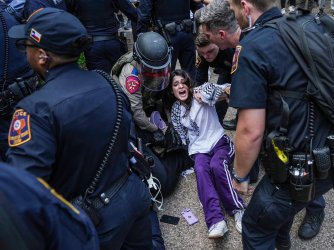
Texas tramples First Amendment rights with police crackdown of pro-Palestinian protests
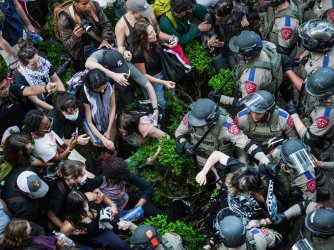
Here’s what students need to know about protesting on campus right now
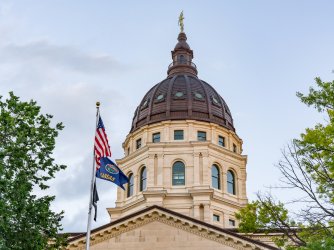
Kansas takes a stand for intellectual freedom
